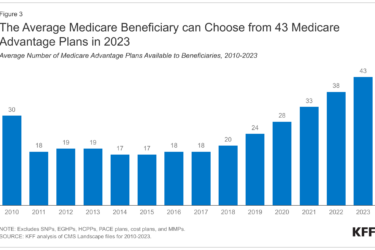
The future of Medicaid – the health program for low-income adults, children and seniors – is now in the hands of the Senate. The American Health Care Act, as passed by the House, would convert the program from an open-ended one to block grants, providing a fixed amount per recipient, regardless of health costs. The bill also caps future program spending. If the bill passes, Medicaid faces more than $800 billion in cuts over 10 years.
That’s bad news for the 70 million people enrolled in the program, including about 9 million dual eligibles – those covered by both Medicare and Medicaid. These are the most vulnerable, often sickest older adults, who struggle to afford food, medicine, and manage their chronic conditions.
As Dan Goldberg points out in this new tip sheet, 75 percent of Medicaid spending pays for acute care and prescription drugs. The rest pays for nursing home care and other long-term care services. This graphic from The Scan Foundation shows that Medicaid pays for about 62 percent of long-term care. That adds up fast. According to this report from the National Health Policy Forum, the average cost of nursing home care with a semi-private room was more than $83,000 in 2012; a private room topped $90,000 annually.
Goldberg offers some excellent ideas for reporters seeking to follow the effect of potential Medicaid cuts in their states. Governors will have to make some very difficult choices, whether or not they expanded Medicaid under the Affordable Care Act.
Dire predictions and worst-case scenarios about the impact of Medicaid cuts are prominent on social media and in numerous editorials recently. Many come from well-known, well-respected sources like this one. They offer some stark counterpoints to assertions by House and Senate members about wasteful program spending.
Ironically, the Center for Medicare and Medicaid Services (CMS) just issued a new directive encouraging states to pursue state innovation waivers. That’s not necessarily a bad thing per se, since some states, like Michigan and Ohio, are successfully implementing more home and community based care. But it’s unusual for CMS to publicly undermine existing provisions of the Affordable Care Act, which is still law.
How will states respond? And as more and more people age into the “oldest-old” category of 85+, what happens if Medicaid funding isn’t adequate to cover those in need of community and institutional care?









